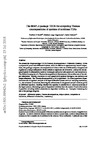The MAPLE package TDDS for computing Thomas decompositions of systems of nonlinear PDEs
| dc.contributor.author | Gerdt, VP | |
| dc.contributor.author | Lange-Hegermann, M | |
| dc.contributor.author | Robertz, Daniel | |
| dc.date.accessioned | 2018-07-30T10:46:30Z | |
| dc.date.issued | 2019-01 | |
| dc.identifier.issn | 0010-4655 | |
| dc.identifier.issn | 1879-2944 | |
| dc.identifier.uri | http://hdl.handle.net/10026.1/11954 | |
| dc.description.abstract |
We present the Maple package TDDS (Thomas Decomposition of Differential Systems) for decomposition of polynomially nonlinear differential systems, which in addition to equations may contain inequations, into a finite set of differentially triangular and algebraically simple subsystems whose subsets of equations are involutive. Usually the decomposed system is substantially easier to investigate and solve both analytically and numerically. The distinctive property of a Thomas decomposition is disjointness of the solution sets of the output subsystems. Thereby, a solution of a well-posed initial problem belongs to one and only one output subsystem. The Thomas decomposition is fully algorithmic. It allows to perform important elements of algebraic analysis of an input differential system such as: verifying consistency, i.e., the existence of solutions; detecting the arbitrariness in the general analytic solution; given an additional equation, checking whether this equation is satisfied by all common solutions of the input system; eliminating a part of dependent variables from the system if such elimination is possible; revealing hidden constraints on dependent variables, etc. Examples illustrating the use of the package are given. | |
| dc.format.extent | 202-215 | |
| dc.language | en | |
| dc.language.iso | en | |
| dc.publisher | Elsevier | |
| dc.subject | physics.comp-ph | |
| dc.subject | physics.comp-ph | |
| dc.subject | math.AC | |
| dc.subject | math.AP | |
| dc.title | The MAPLE package TDDS for computing Thomas decompositions of systems of nonlinear PDEs | |
| dc.type | journal-article | |
| dc.type | Journal Article | |
| plymouth.author-url | http://arxiv.org/abs/1801.09942v1 | |
| plymouth.volume | 234 | |
| plymouth.publisher-url | http://dx.doi.org/10.1016/j.cpc.2018.07.025 | |
| plymouth.publication-status | Published | |
| plymouth.journal | Computer Physics Communications | |
| dc.identifier.doi | 10.1016/j.cpc.2018.07.025 | |
| plymouth.organisational-group | /Plymouth | |
| plymouth.organisational-group | /Plymouth/Faculty of Science and Engineering | |
| plymouth.organisational-group | /Plymouth/Faculty of Science and Engineering/School of Engineering, Computing and Mathematics | |
| plymouth.organisational-group | /Plymouth/Users by role | |
| plymouth.organisational-group | /Plymouth/Users by role/Academics | |
| dcterms.dateAccepted | 2018-07-25 | |
| dc.rights.embargodate | 2019-8-10 | |
| dc.identifier.eissn | 1879-2944 | |
| dc.rights.embargoperiod | Not known | |
| rioxxterms.versionofrecord | 10.1016/j.cpc.2018.07.025 | |
| rioxxterms.licenseref.uri | http://www.rioxx.net/licenses/all-rights-reserved | |
| rioxxterms.licenseref.startdate | 2019-01 | |
| rioxxterms.type | Journal Article/Review |


